Aged 40, my boat is an old lady compared to most of the yachts mooring in the marinas. I really like the classic cruiser-like lines of my Fiskars King´s Cruiser 33 and from the first moment I saw her fell in love with SY OLIVIA (which can be read here). Now that she is finally paid for and secured on dry land to be safe out of water during winter-season, I was spending the last two weeks with working out what to finally do with her. But where do I start?
Dreams coming true.
To be honest: Owning this boat is a child´s dream coming true. This ship is the materialized possibility of really acting out all the dreams I´ve had when I was a little boy. Even if it´s “only” the Baltic Sea where we will set sails in the end and not the far away destinations like the Caribbean or Cape Horn – it´s still the possibility of one day mooring in front of New Zealand, Tonga or Galapagos which is so energizing. Being outside, experience the forces of mother nature, the ocean, weather and we in the midst of it all. It´s everything right here, in my tiny boat.
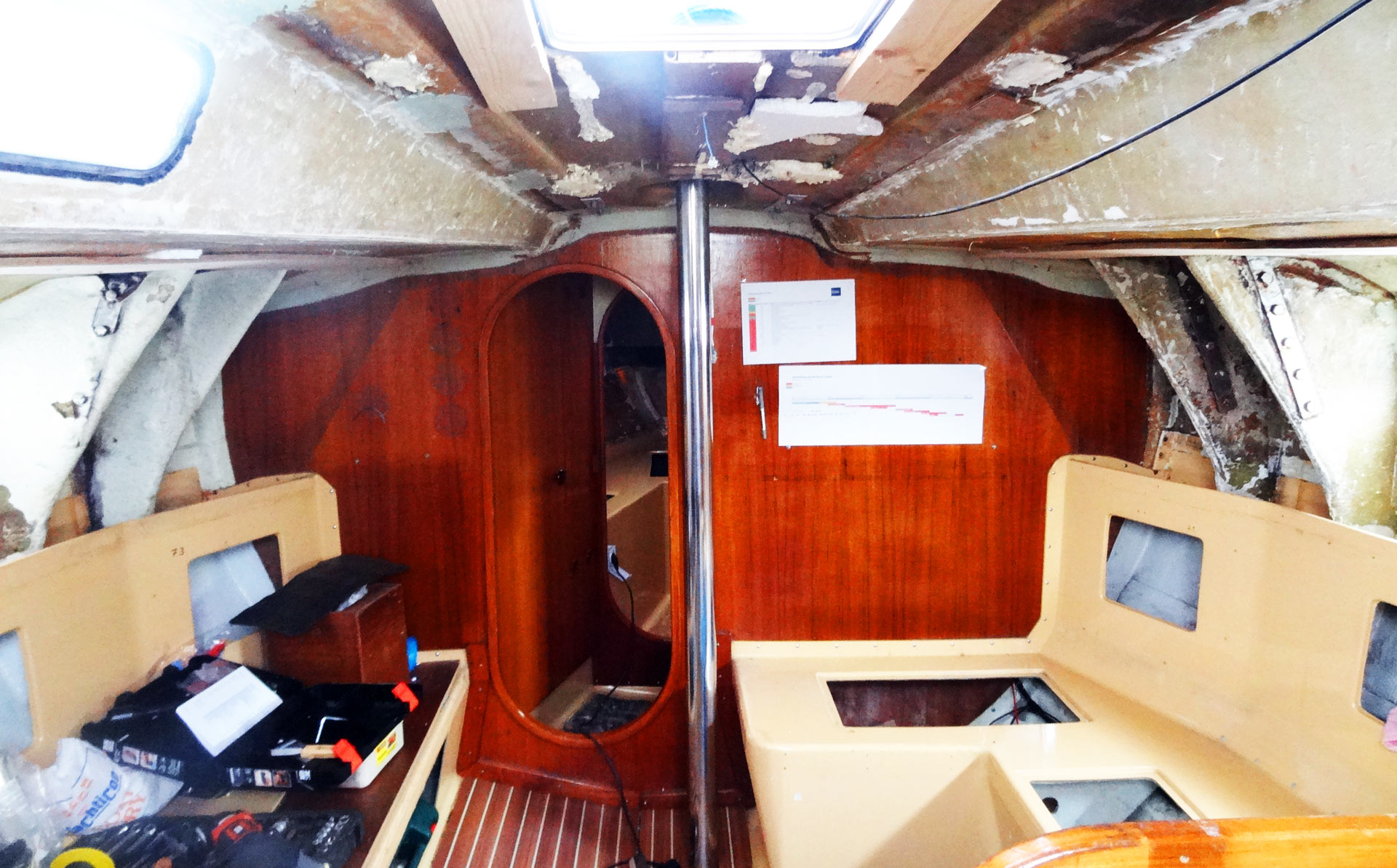
But we will have to arrive first. I mean, we have to accept the 33 feet as our home. And here it gets complicated. We love OLIVIA, but, well, let´s put it this way: A lot of people have spent a lot of time in her during the last 40 years. The boat breathes “them” more than us. So, refurbishing and refitting the ship for me was a matter of course from the first moment on.
Well.
“I´ll refit the boat.”
That´s a sentence spoken out all too quick – but what does it mean in the end?
A lot of work: How to structure yourself.
Not having the money to pay professional people to do the work for you means, simply, to do it yourself. From my perspective that´s the perfect chance to snap two flies with one hit. First of all, doing all the work (well, most of it certainly) by myself would give me the chance to get to know my boat from keel to mast-top and from upside down. Reduce the ship to the bare hull and rebuild her would mean in the end that I´d know every single screw, every wire, every this and that. A factor of safety in as well.
The other chance was to look behind the nice cover. Taking away all the panels would make visible and accessable all of her tiniest corners and brackets. I had taken close looks onto every possible spot when I was still thinking of buying her (full article of how to buy a used yacht can be read here) but I had certainly had no time to look at everything.
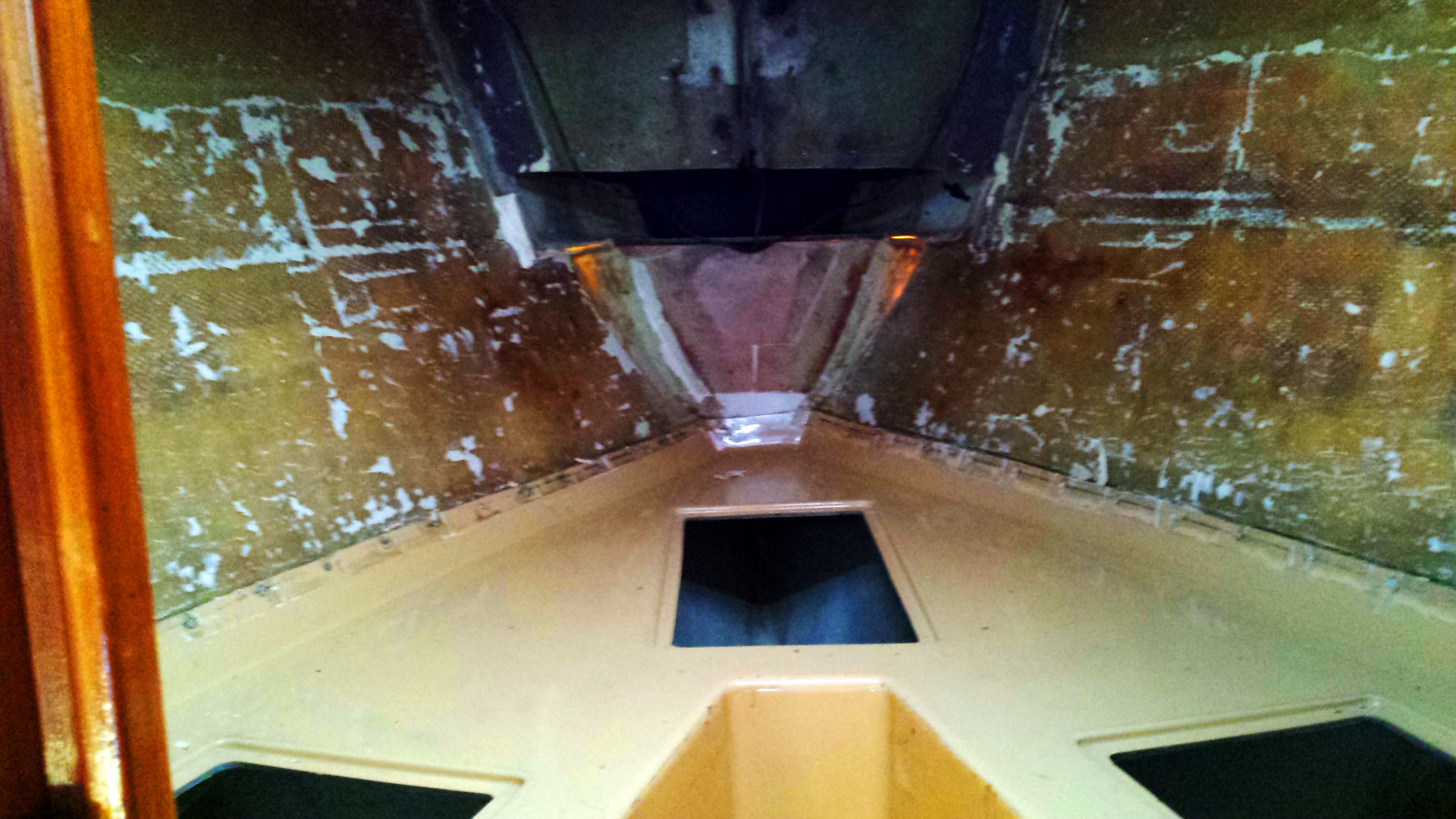
First decision therefore was to split my high flying plans in two: First year it´s just the interior I want to work on. Second year I will go for her outward appearance. Why´s that? Well, I´m travelling with wife and children. It´s my first priority to have them feeling comfy and at home onboard SY OLIVIA. I want them to recognize the boat as a part of their life: So, rebuilding the boat with an all new interior was not only necessary but logical as well.
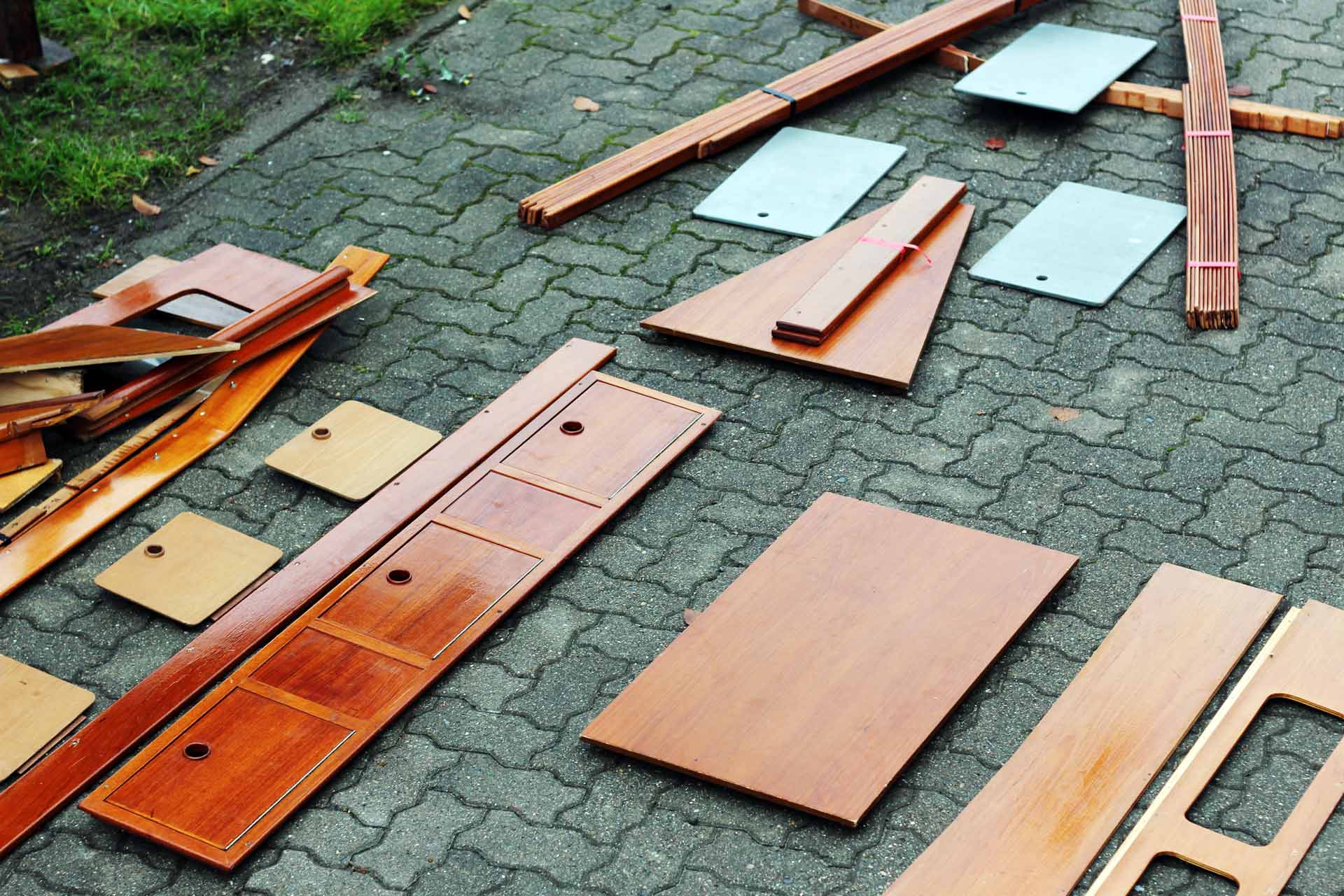
After having cleared that this year it would be “only” the inside I was to work on, I started to empty the boat. From the bowsprit to the toe-end of the quarter berth I removed everything from OLIVIA, looked at every item and … most time threw it into the trash. 40 years of constant usage, there´s a lot of crap on board a ship I can tell you. Finished with taking away every hatch and flap and working for 16 work-hours in total I had some 6 big blue sacks of trash thrown away. But I had also found some “treasures”. Two original and still sealed throw-away grills dating from 1987, a Milka cholclate bar from 2003, some 15 big candles down in the keel, a 20-pieces-set of Nirosta screwdrivers and wrenches and some very useful spare-parts for my engine.
Plans´n´schedules
Well, I am a professional marketing-guy so making plans and schedules is a no-brainer for me. And it´s useful to structure my work, keep a close overview, inform my wife, track my financial spendings, working-hours and organize the time I have in total. I love Excel, because it´s an excellent way to visualize projects. Knowing that I´d had only weekends and my holidays for working on the boat, I could recount the total-time in working hours that I would be able to spend.
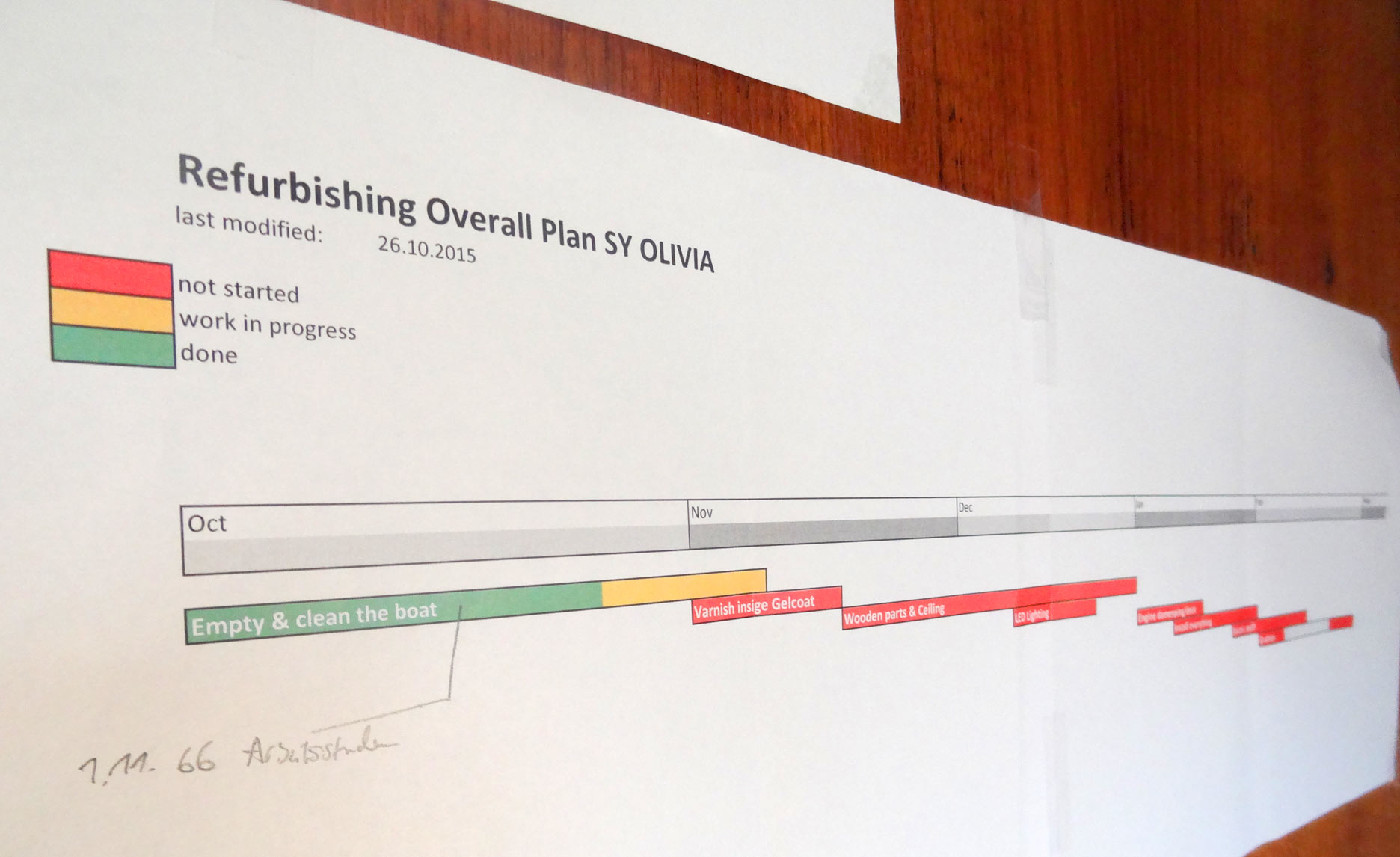
In average, I can do four working-hours a day. That means eight hours per weekend. Four weekends per month sum up to 32 working-hours. Having seven months until next sailing-season would mean a minimum of 224 working hours in total. Some two weeks of additional spare time and “holidays” add up to a total amount of working time of 280 working hours. Well, there will be days on which I will do certainly more work so that I define the total time available to 300 working-hours.
That´s a figure to start with. But will it be enough? So the first plan was the overall refurbishing plan, spanning from late September to late March, I sub-devided the total work into milestones.
Yacht interior refit – what does that mean?
Interior refit, that simply means to make an otherwise unfamiliar, alien surrounding feel as it was your home. So, removing all the old and used parts like wooden and leaether covers, taking off all cover panels and styling-elements was the first work to do. Easy said: Hard task. Unscrewing the wood took me three days alone. Most of the wooden stuff was in perfect shape so that a complete grinding down, colouring and varnishing will make them look brand-new with ease.
I discovered only one spot where a small – but constant – amount of waterdrops from the starboard chain-plate had done harm to the wood in a way that I will have to renew everything. Which is a good sign: The rest of the boat is dry and sealed.
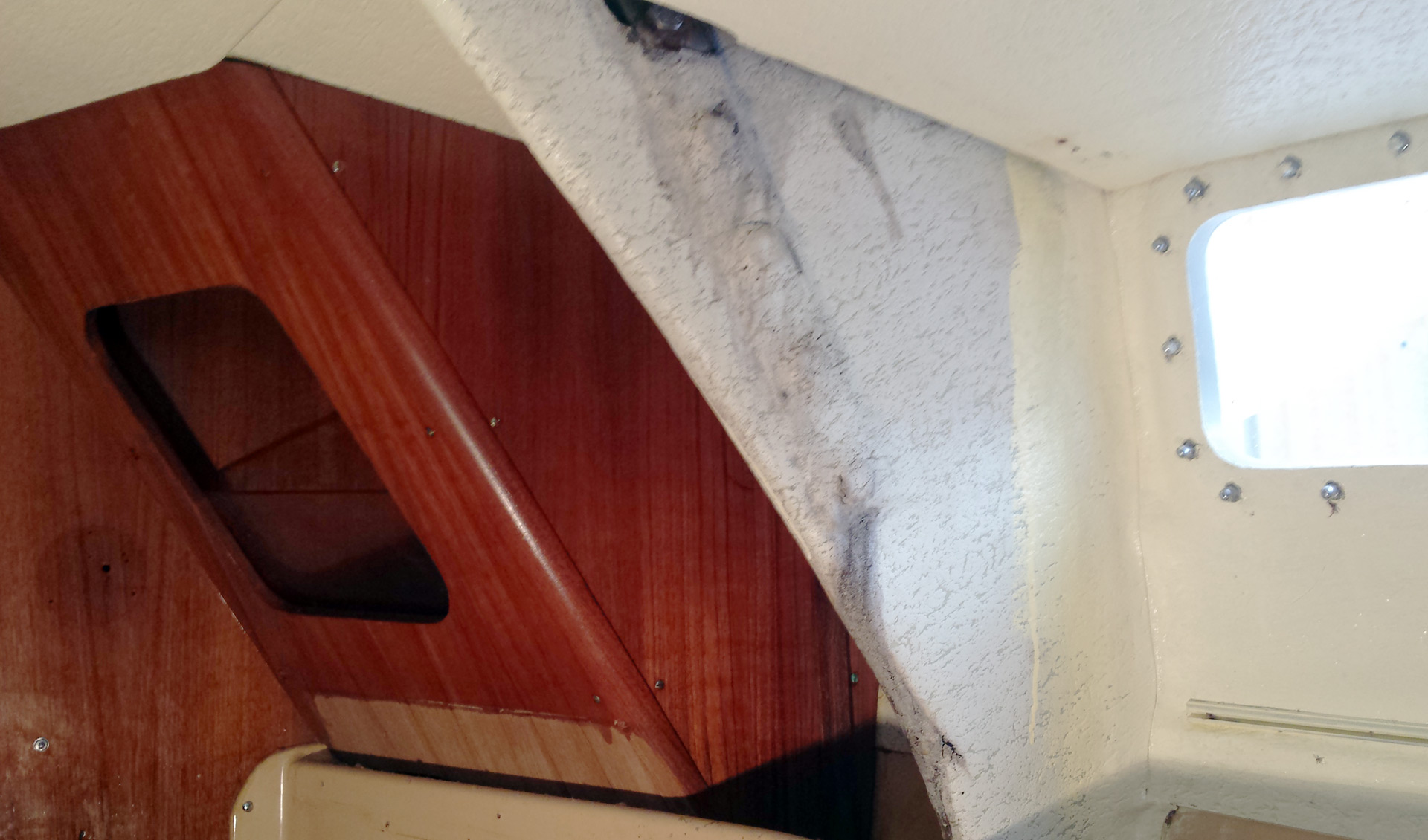
Having taken off all the wooden stuff, next thing was the ceiling. Awful to look at, my pre-owner had previously been unsatisfied with the design as well, as he apparently varnished the whole ceiling. The work was done improperly and the finish was poor. The whole ceiling will go to the trash – I find it only useful as master plates for the new-made ceiling parts.
Last but not least, the leaether-coating with which all of the yacht´s interior is covered. It´s glued to the inner shell of the GRP-hull and can only be retrieved my machine. A tiring, loud work that makes my whole body aching as I´ll have to work over head, on my knees and in various other near-snakeman-like positions. Speaking of a sore body: The worst part is taking off the deck-plating, on which I´m currently working on.
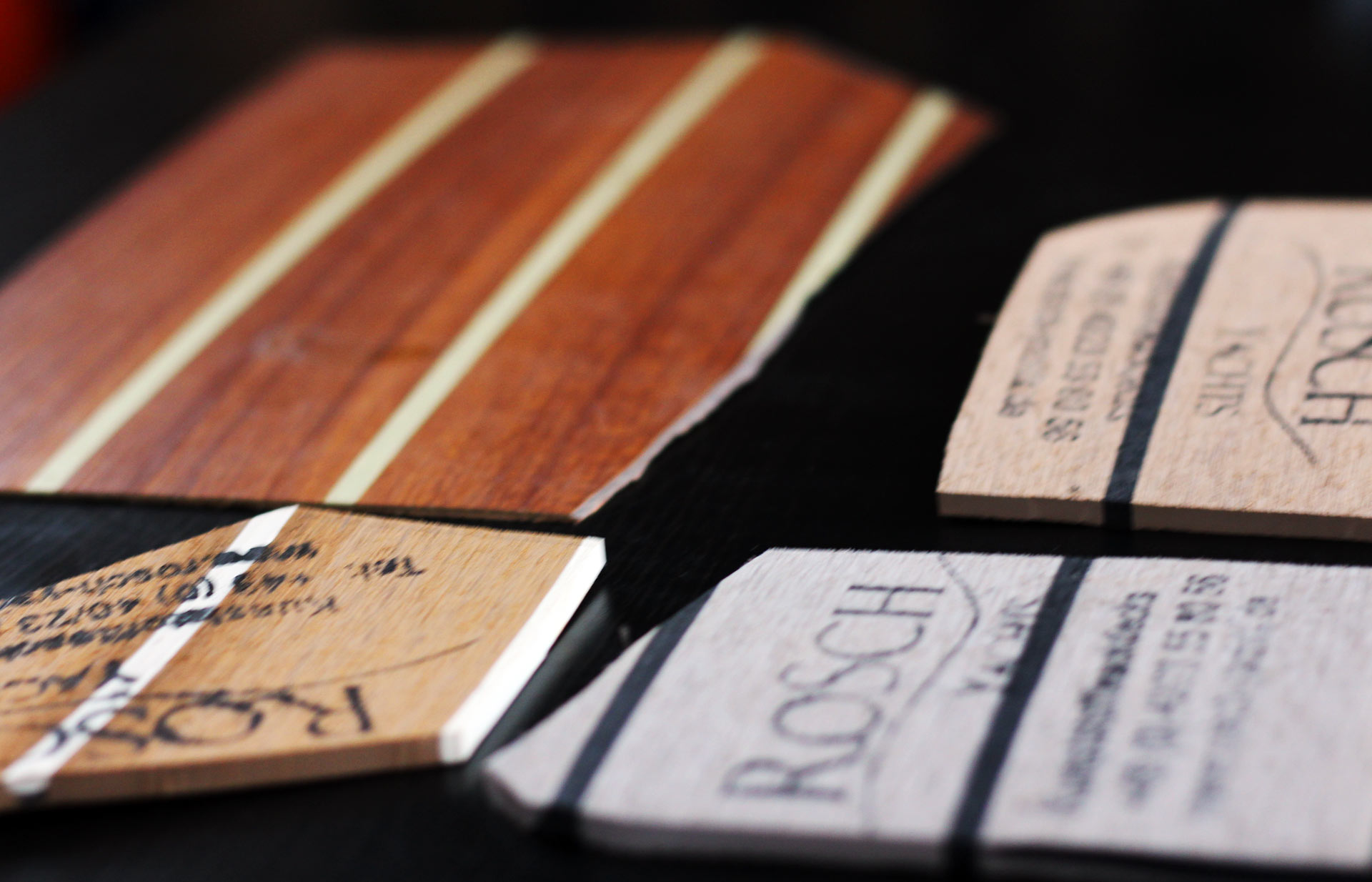
Until now there are 62 working-hours already spent – having at least 20 more to go until I think the first of the overall eight milestones will be marked as “done”.
Starting with a white canvas.
Having an empty, clean boat means to have the white canvas an artist needs to paint his picture on. So do I need a bare boat to bring to live my ideas of the perfect interior design. First of all there is the pure, uncovered GRP-surface. As my boat was built back in 1975 this yellow-ish oldschool colour may have been at the fancy top-notch end of the yacht design, nowadays this paint reminds me of old ladies underpants. Not sexy. Grinding and priming these surfaces and varnishing it with a modern, clean yacht-white will be the first step to bring this Kings´s Cruiser to the 21st century.
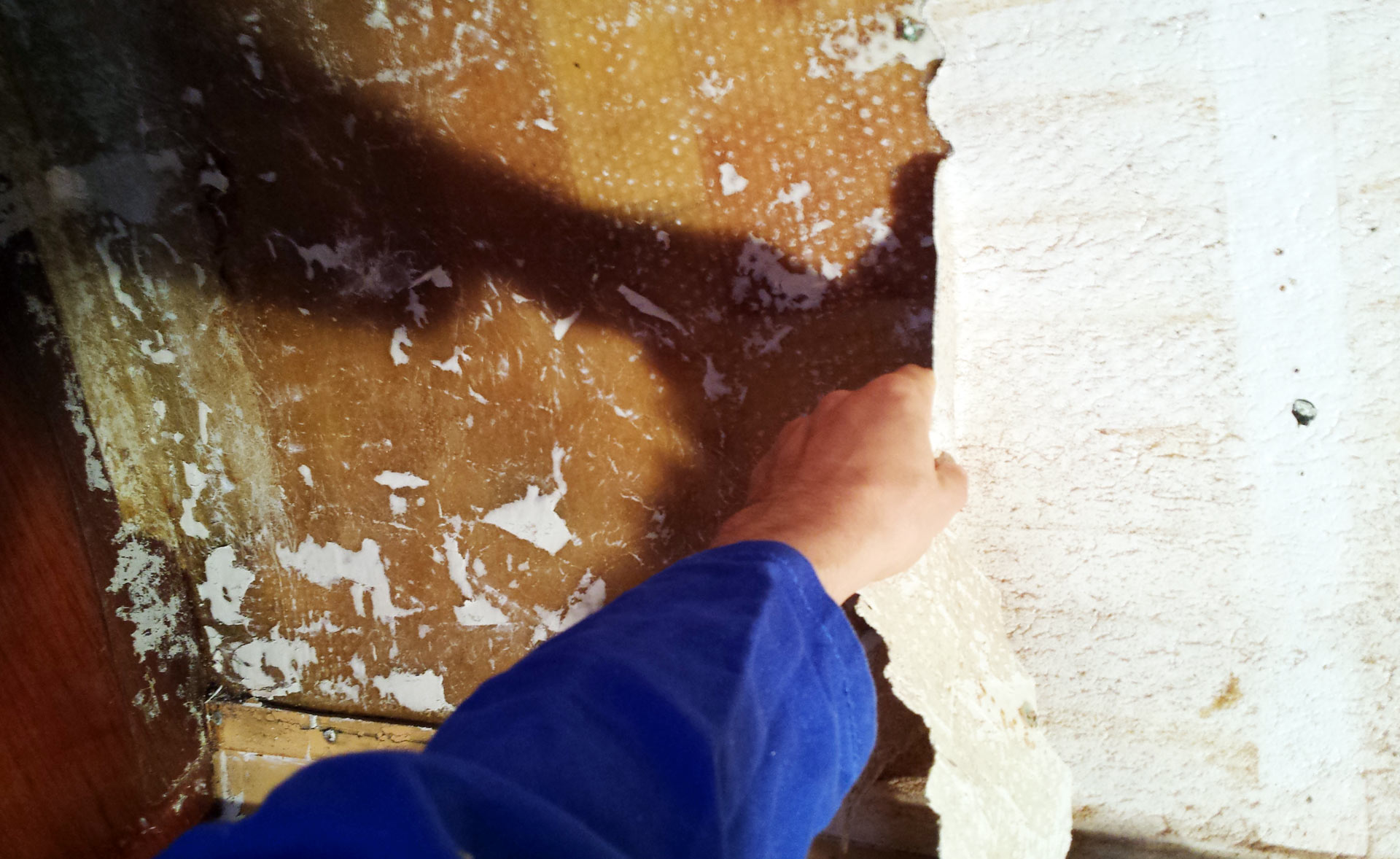
Having done that, it´s the leaether-coating I want to re-install. Having to choose between the ultra-clean (and brutal) white, a more pearl-like white and a grey we´ve decided to go for the pearl-white. That part will be tricky since removing the old coats meant to destroy them. There are no patterns available anymore so I´d have to painstakingly reconstruct all the very complex parts.
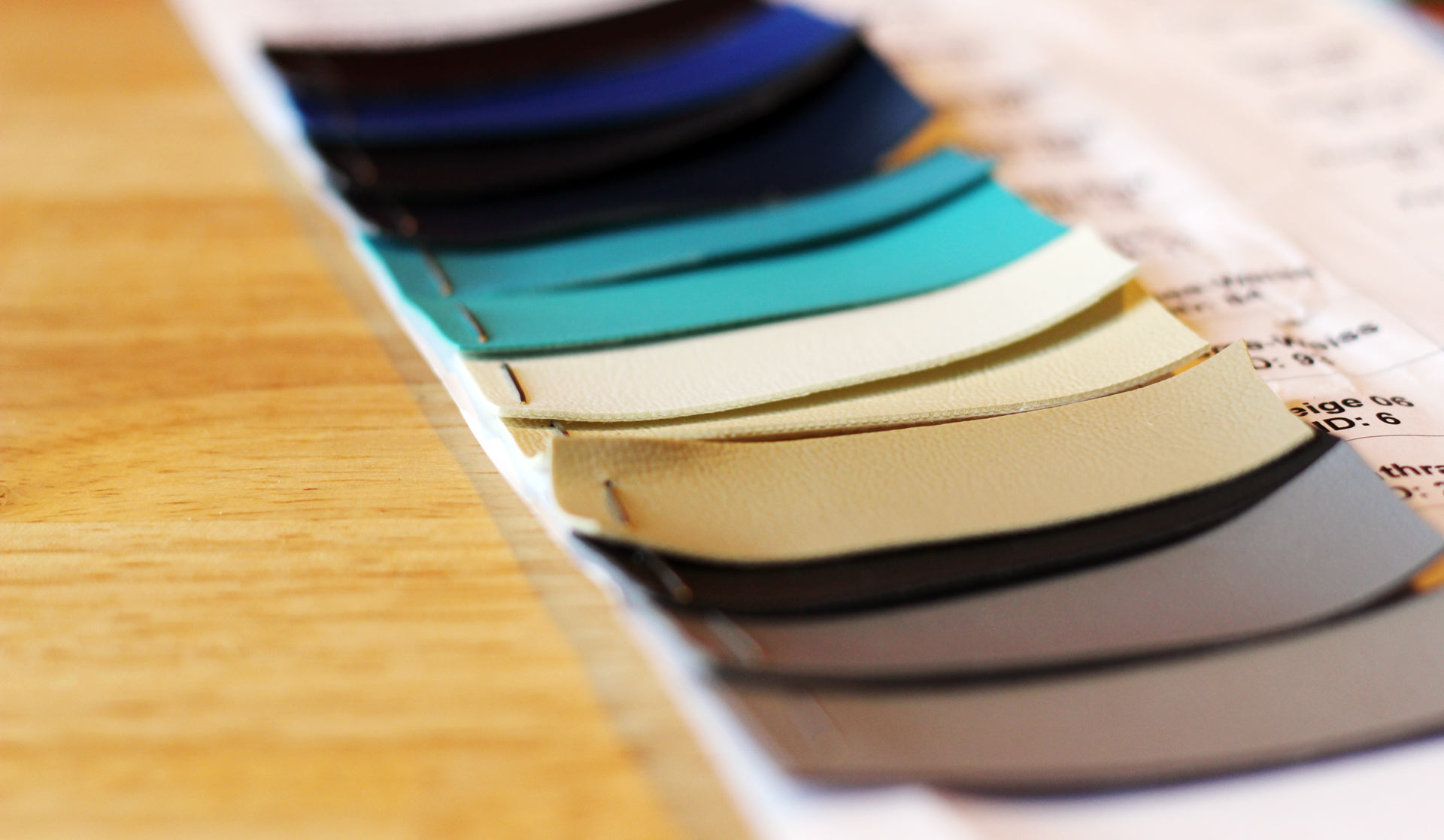
Going for the ceiling, I am working on a solution which will combine the original plywood-parts with my idea of having a “real” leaether-look commonly used in cars today. All the wooden stuff will be redone with new basic colouring and fine varnish and last but not least a completely new set of the 21 cushions needed to fulfill my dream of a new interior for OLIVIA.
Classic sailing boat vs. modern luxurious yacht?
And here the problems set in. From a DIY-standpoint I find there´s no real challenge in refitting the boat. I am familiar with basic mechanical skills as I can draw a lot of experience from building our family´s home during my teenage-years, it´s only the electrical stuff (I go for LED-lighting inside) I am really afraid of – and that´s together with new cushion – the only part of the game where I won´t be out on the field and pros will take over.
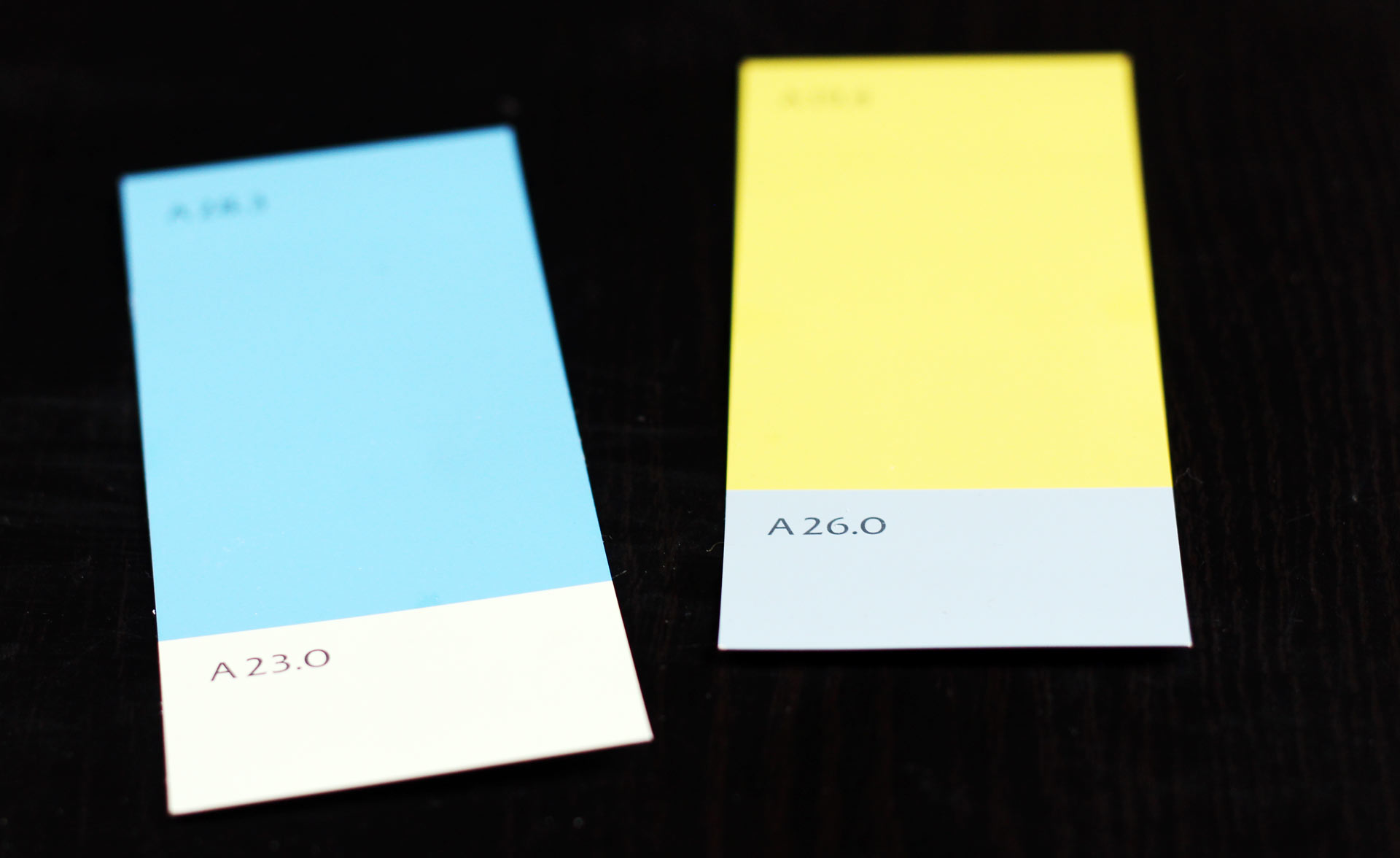
But the real hard question is a more prosaic one: How should the boat look like in the end? Reading all kinds of maritime stuff I do have a certain idea of how a yacht should look like. But in detail, there is so much possibility how to do it. Hundreds, if thousands of different options, are buzzing before my inner eyes. And make me crazy.
My ship is 40 years old. So, conclusion is near to refit her in “her” style: Go for wood, mahagony and teak, classic colours would be white, blue and … well, wood. Fullstop. Nothing needed more. Except for the accessories like brazen chrono and barometer. A classic ship like it has been beamed here right out of Melville´s “Moby Dick” or Verne´s “20.000 Leagues under the Ocean”.

Or do we go for modern? What an interesting concept this would be. Try to fit in modern styles, colours, patterns and concepts into a hull that is older than myself. Kind of perplexed we postpone these decisions once more to the future. Too big for hasty shots.
Colours, patterns & wood.
Roaming the Hanseboot yacht fair these days, we take a look into a lot of modern day yachts. Apart from the fact that they offer far, far more space (even a current 31 feet boat is a lot more spacious that our 33 feet classic cruiser) they do look different. More light at all, standing-height all over the place and lighter, friendlier colours that remind me of a designer kitchen more than of an oceangoing vessel characterize them. No dark areas, no darkened wood (which is a problem with OLIVIA since her wood is dark and you cannot brighten up wood) and mud-tones all over the place. White to pearlish coulours, violet and a lot of grey dominate nearly all of the interiors we´ve seen.
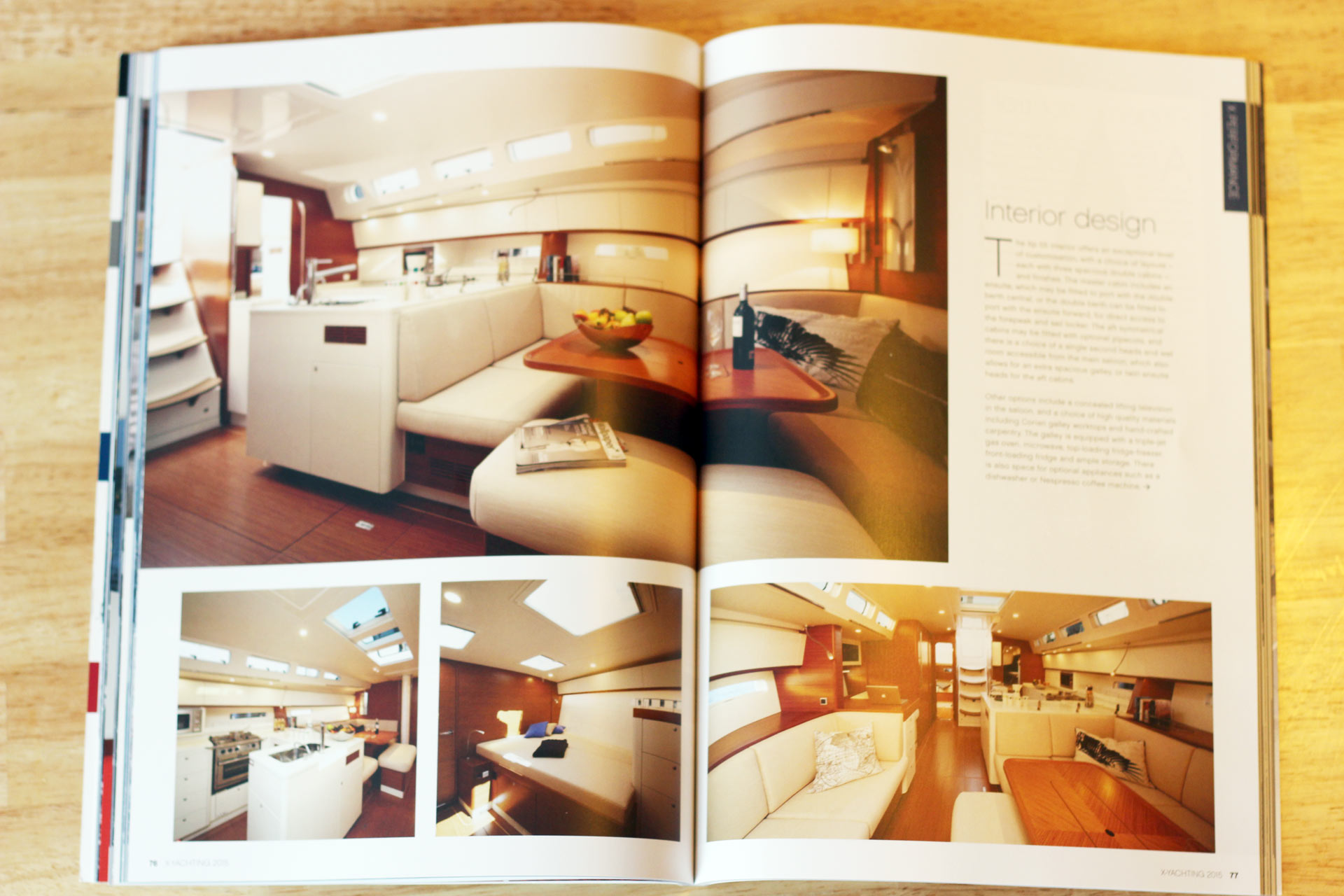
Having brought a variety of different styles of deck plating, it´s the grey/black pattern that was hitting our eyes first as “how interesting”. No wooden deck-plating but … grey? Combined with lightgreen and grey-blue? Or foggy-blue and beige? Hell, that´s no Maybach I´m configurating, it´s a sailing boat …
And then it´s the Hallberg-Rassy and an astonishingly beautiful Henningsen & Steckmest which brings me back to the picture of our King´s Cruiser as a classic sailing boat. No apple-green, lemongrass and other fancy tones, maybe it´s the century-old, classic look of white/blue-stripes, mahagony facing and the old pattern of deck-plating which will suit our old lady best?
Our choice: A classic design with modern elements.
We don´t have a definite decision yet, but I think we´ll go for a crossover of both. Combining a modern LED-lighting concept with colours and – especially for the most defining part of the interior, the cushion – the feel of the surface in the use of material, we try to update the ship to 2015. But there won´t be a TFT-screen in the saloon, neither a glass ceramic-cooking surface or a laptop-station.
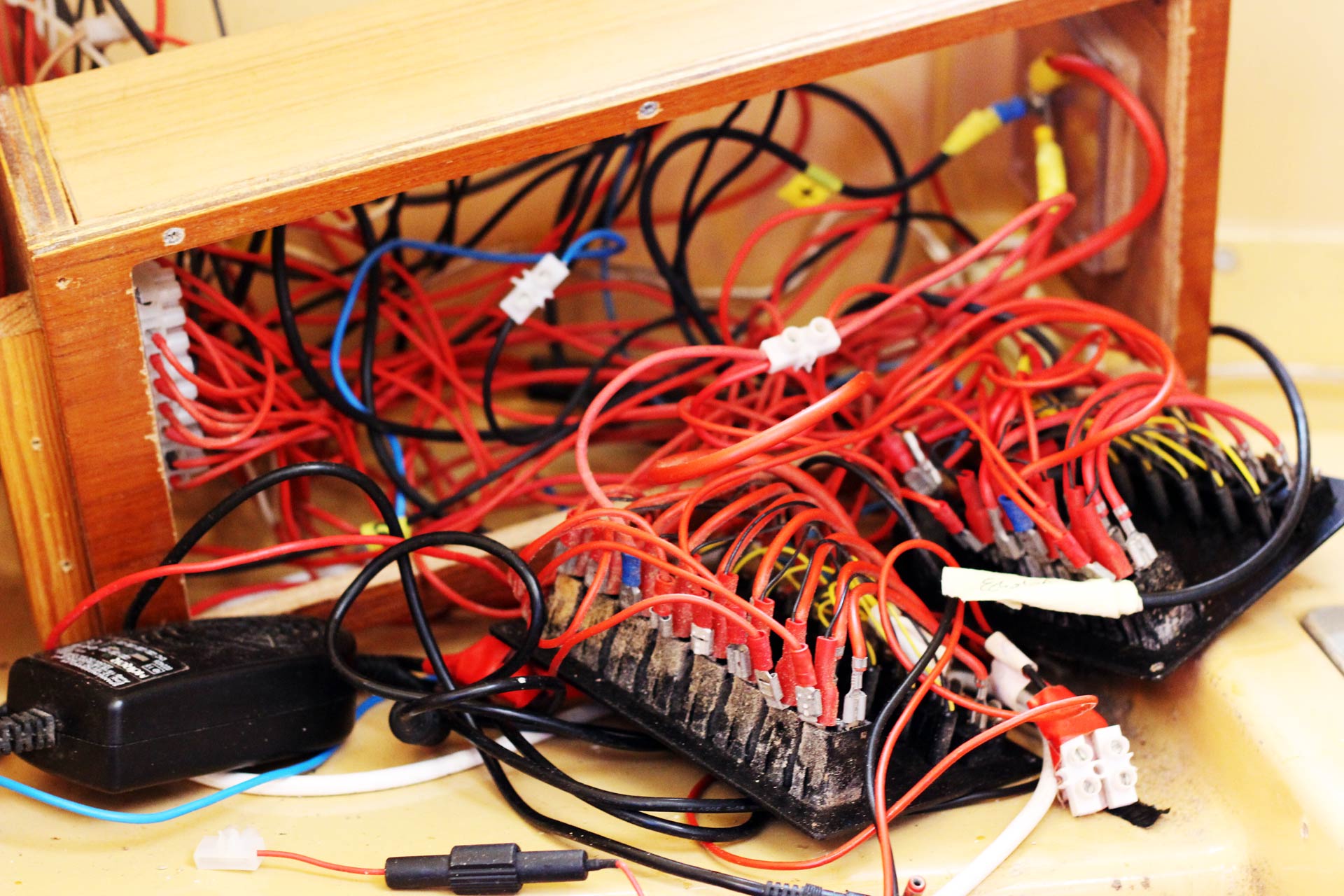
Looking at the King´s Cruiser 33, her father Pelle Petterson has designed a design classic in itself. The boat doesn´t need another artist to be a fine boat. It already is one. So my primary task will be to preserve her beauty and to try to bring back this feeling of … wow. A mixture of Jules Verne and the romance of the Clipper-ship FLYING CLOUD but having a modern mobile home, comfortable and home to a modern day family.
A balancing act, truly. But one of the most challenging and satisfying tasks I could imagine right now.
A work in progress.
Having my overall plan is a good guide. But not of great help. So, on a day to day basis I do work with another Excel-sheet, the to-do list. Here I break down every milestone in smaller tasks and plan ahead day by day. In doing so, I can pre-think the tasks, note questions and try to collect knowledge, ask people who have the know-how and – an otherwise big danger – don´t forget the tiniest details.
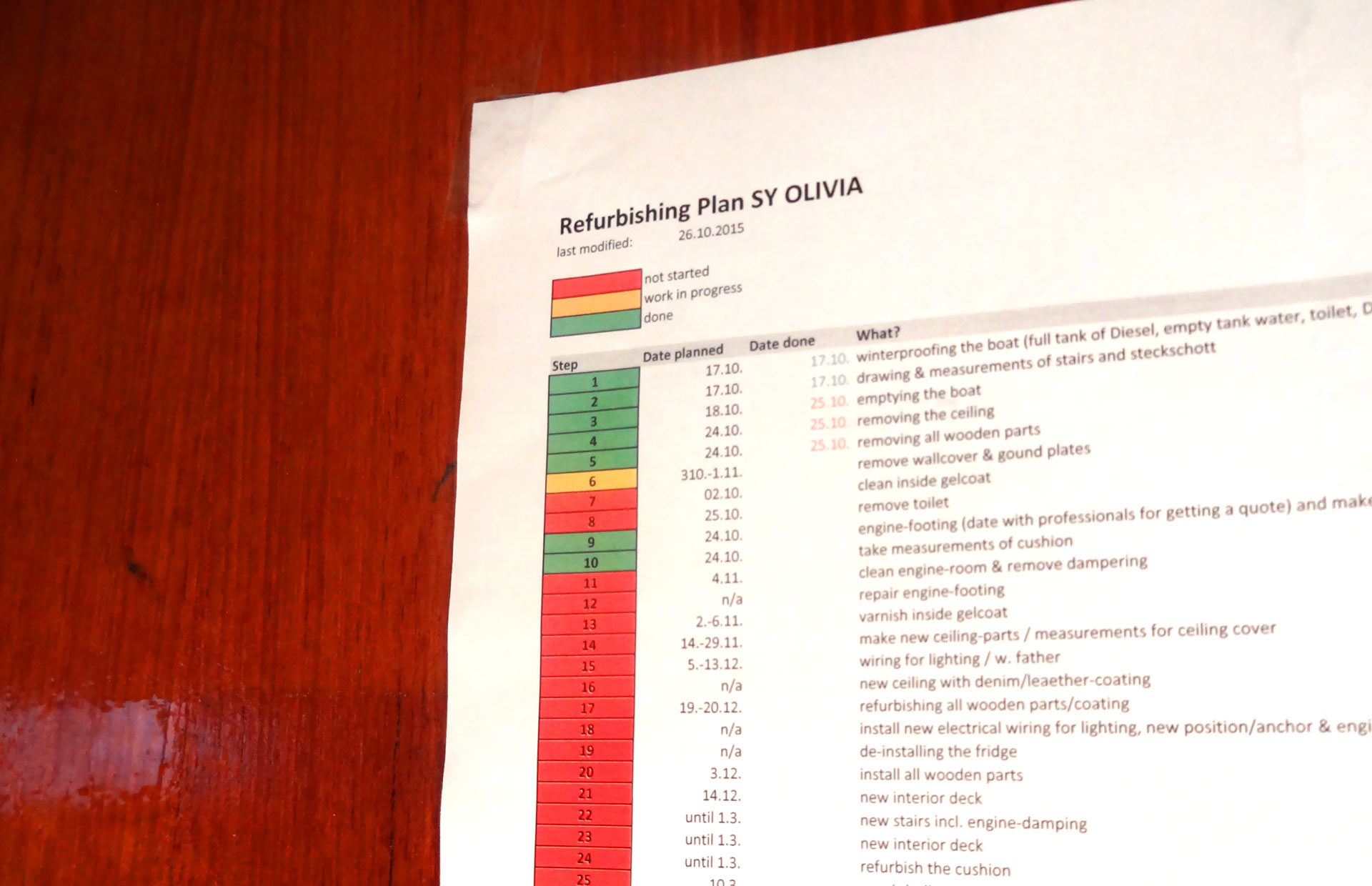
So far the list comprises of 29 to-dos of which 7 are “done”. Some tasks will split into two or more, others will merge. Some tasks will turn out as being planned way too optimistic – such as the removal of surface-stuff, which takes 4 times the amount of work as imagined – some will turn out as consuming shorter amounts of precious working-time. Life is life.
It´s a fantastic voyage, a work-in-progress. A huge mountain of work but indeed, it´s a very satisfying one. I cannot wait to see everything coming into place step by step, how my ideas turn reality, how everything unfolds and sums up to a whole new unity, a new ship, hopefully meeting all the expectations of my family and myself. Gicing OLIVIA a new look, trying to preserve her rich history, her 40 years of expertise, adventures and cruises, carbing out her character as a Fiskars King´s Cruiser as well as a modern ship of 2015 is a huge task. But one that makes me smile everytime I think of it.
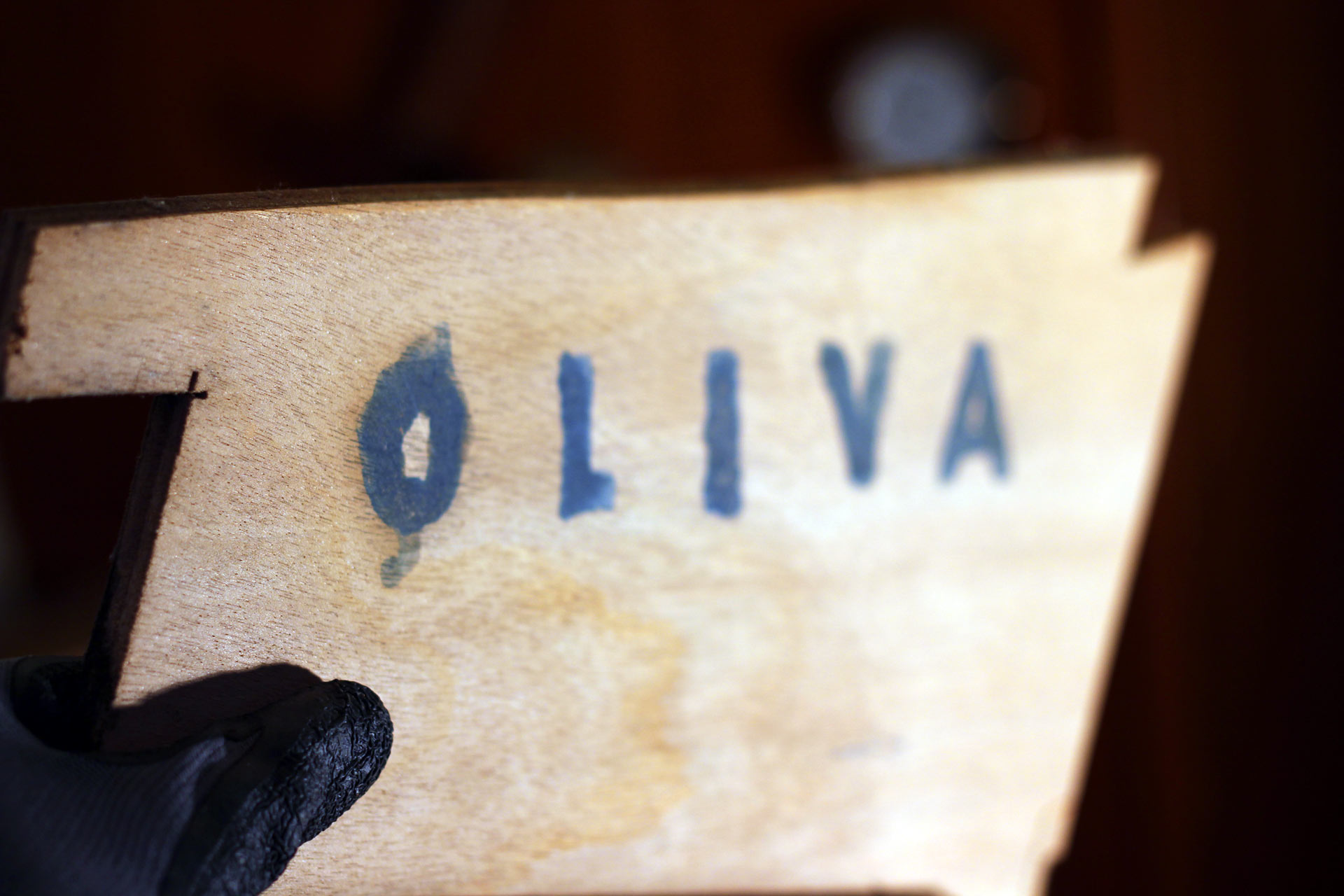
Well, at least until it comes to removing ground plating. I hate this point on my list …
But anyway, once done, maybe then we´ve decided for which colour-scheme out of four we should go. Time will tell – and you will read it here on NO-FRILLS-SAILING.com
What are your experiences with refitting your yacht? What was the most annoying, what´s the most satisfying part? I am looking forward to your comments.
